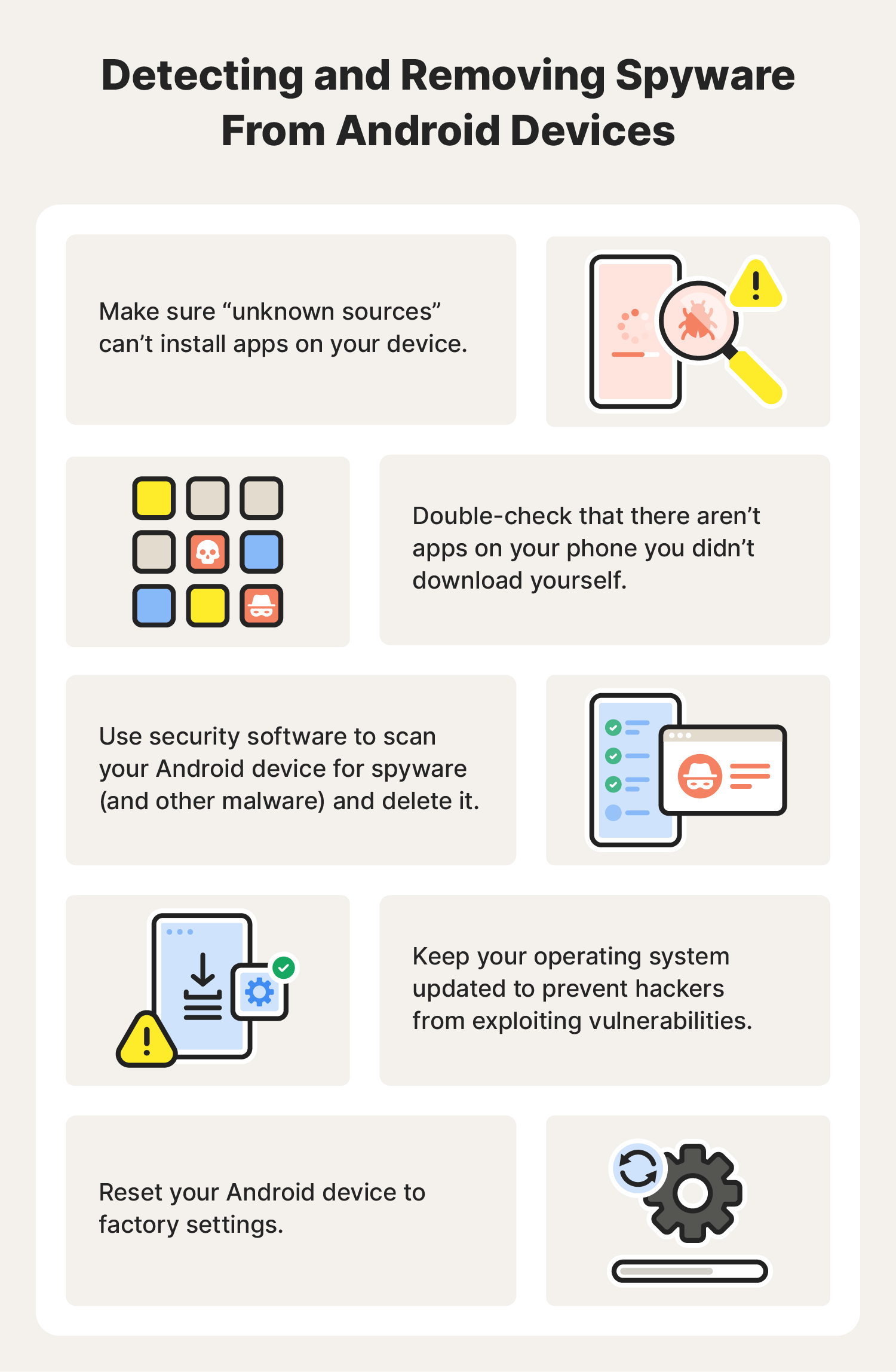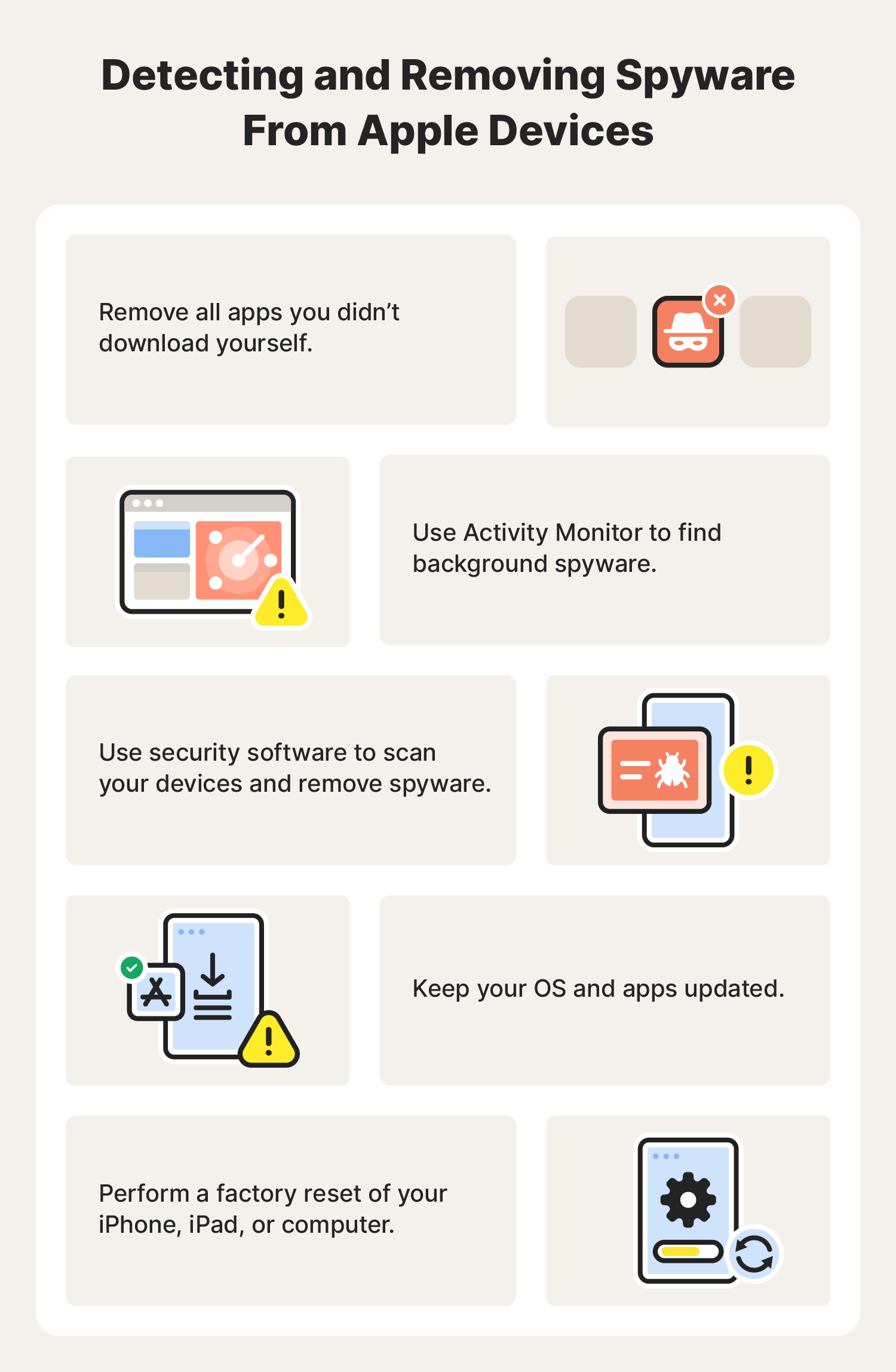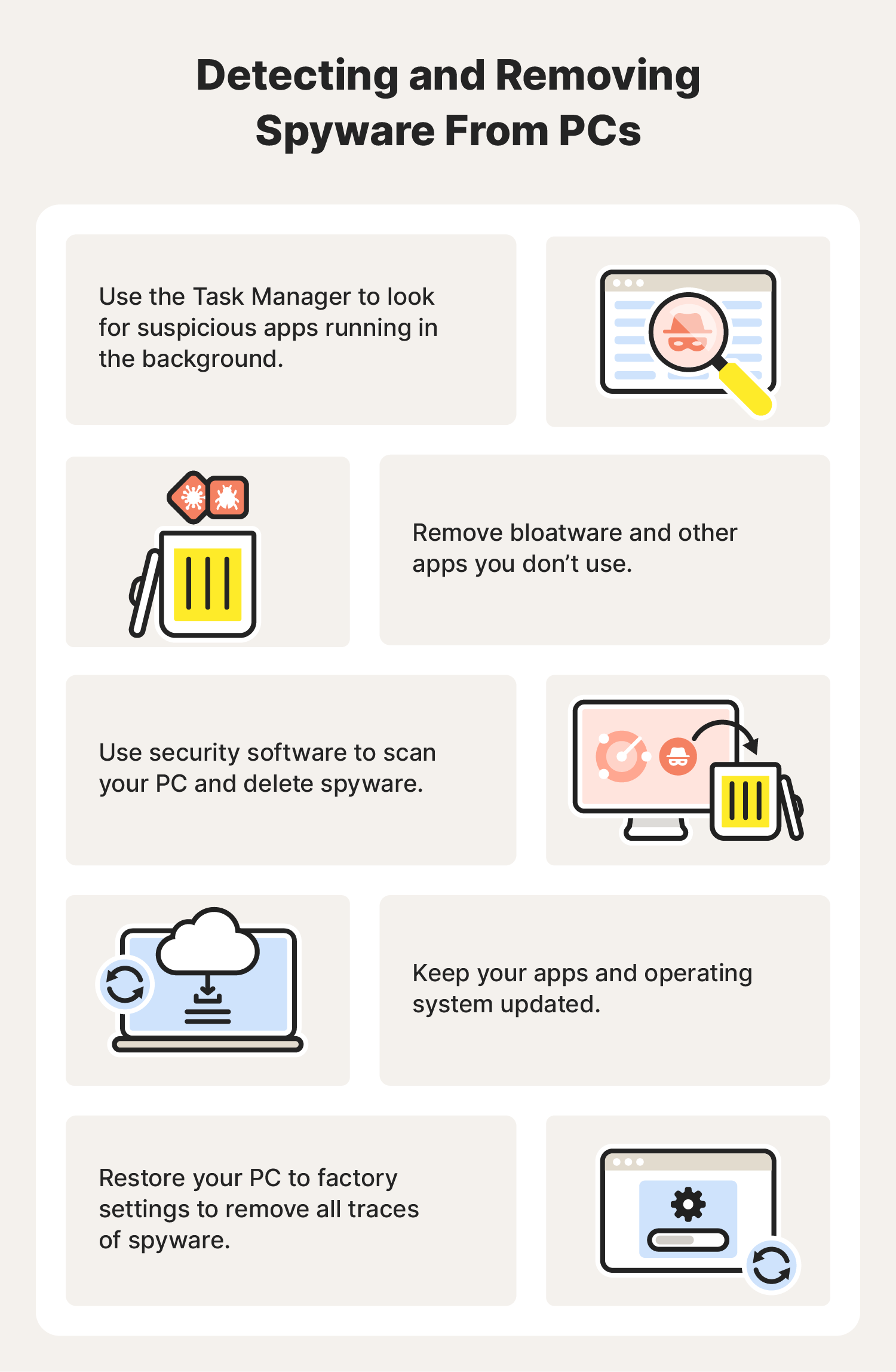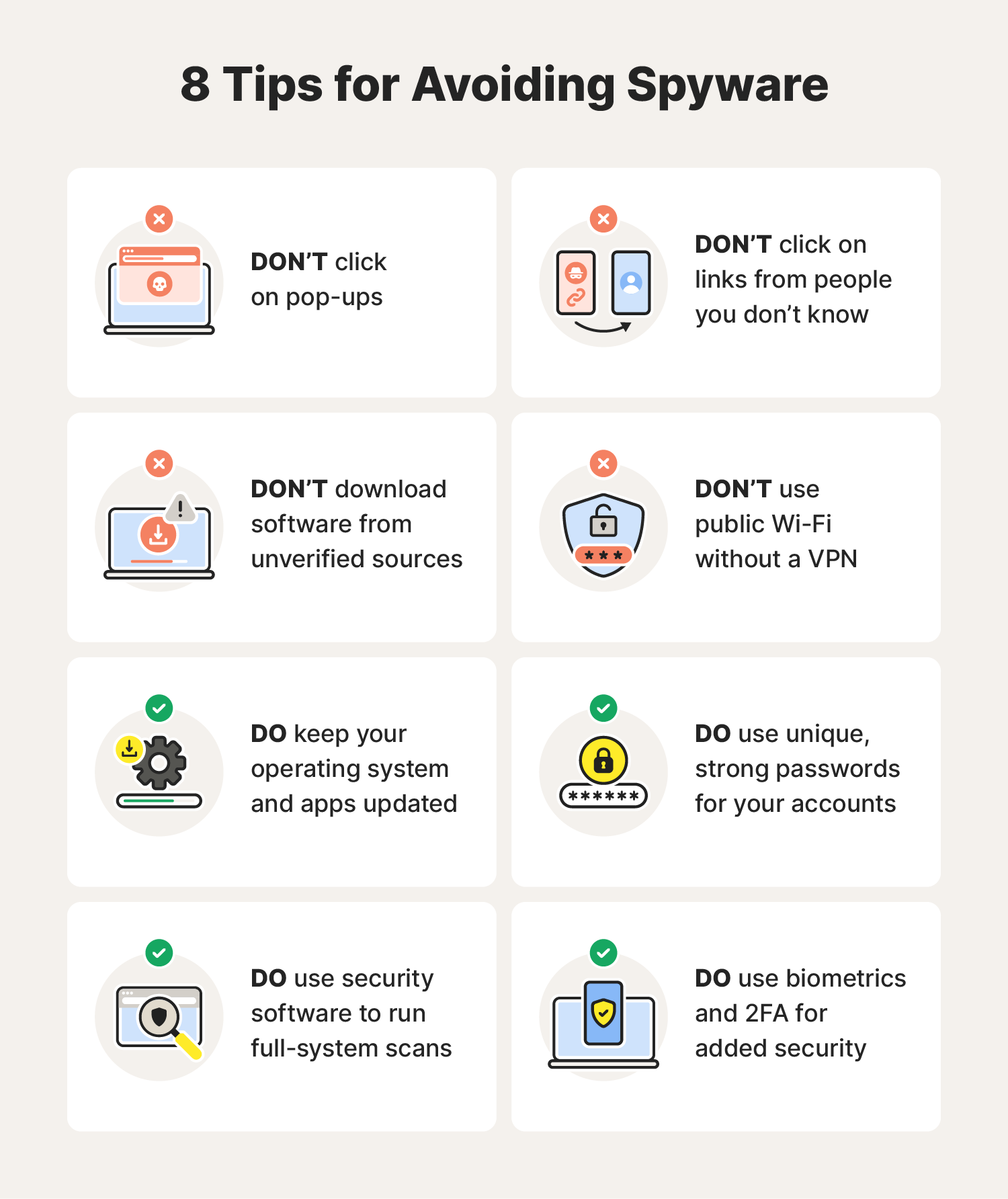How to detect spyware and remove it

Learning how to identify spyware may not be easy, but it’s essential for ensuring your online privacy. Learn spyware detection steps for Macs, iPhones, PCs, and Android devices. Then, get dedicated security software to scan your device and help detect and remove spyware before it can cause problems.
Spyware is a type of malware designed to spy on you by monitoring what you do on your phone, computer, or tablet without your knowledge.
Some spyware programs are installed by someone who has physical access to your phone, while others are downloaded and installed because you visited a certain website or clicked on an unsafe link.
No matter how you got the spyware, there are ways to tell if your device is being tapped, tracked, or monitored by spyware and steps you can take to remove the infection.
First, you need to know how to identify spyware on your device. Here are some of the signs of a spyware infection:
- Your device is running slowly: Some spyware requires a lot of resources to run, which slows down everything else. You may also notice that programs take longer to start.
- A lot more pop-ups when you’re online: If you’re seeing these, it might be because the spyware on your device has disabled pop-up blockers on your browser.
- Difficulty logging into secure sites: This could be because the spyware has set up a spoofed site that collects your login information before sending you to the real site.
- New toolbars on your browser or a new homepage: Spyware can reset or actively change homepage settings, and it might install toolbars that collect your information.
- Security software isn’t working: Advanced spyware knows that good security software will find it, which is why it's designed to turn off or otherwise disable antivirus and anti-malware protection.
How to detect spyware on Android phones and devices
Detecting spyware on an Android device can be pretty straightforward, as long as the malware isn’t extremely complex or good at hiding its tracks. While these steps may vary a little depending on your device, here's how to look for spyware on your Android-powered phone, computer, or tablet.
- Check the “Allow unknown sources” menu. Use the search function on your phone to navigate directly to “Install unknown apps.” If it is on, it allows your phone to download and install apps not found in the Google Play Store. Turn this off to reduce the risk of installing spyware if you click on an unsafe link or open an unsafe attachment.
- Make sure you downloaded and use all of your apps. While you probably won’t find an app called “spyware” on your phone, periodically check that all the apps on your device are ones you actually use. Delete old apps because they could become vulnerable to hackers in the future, especially if they’re not maintained by developers. And if you find an app you didn’t download, delete it right away.
- Scan your device using security software. Programs like Norton 360 Deluxe offer protection from malware and hackers, and they can use a spyware detector to examine your system for known threats with a method called signature detection. Security software can also use heuristic detection to look for code or suspicious behavior based on the way it understands how normal programs work and how malware works.
How to remove spyware from Android devices
While some types of spyware on your Android may be very difficult to get rid of, there are a few steps to try when you need to secure your Android device.
- Use security software to delete spyware. Many antivirus or anti-malware programs are designed to isolate and delete spyware. Double-check that the software is compatible with your operating system before downloading.
- Update your operating system and apps. Updating your operating system and the apps on your device can close vulnerabilities and shut out spyware trying to use exploits to gain access to your device.
- Perform a factory reset. While this is extreme, it will eliminate most forms of spyware from your Android. However, some malware can survive a factory reset. If you reset your phone and it still behaves the same way, you may need to replace it.

How to detect spyware on an iPhone or Mac
The most likely way for an iPhone or iPad to be infected with spyware is for it to be jailbroken. While jailbreaking an iPhone is legal (and allows you to install apps that aren’t available in the Apple App Store), it creates a lot of potential vulnerabilities. Hackers using a zero-day exploit is another way for spyware to get onto an Apple device.
While iOS devices may be more secure than Android devices, they aren’t impervious to the dangers of spyware. Knowing where to start looking for this type of malware is the first step to removing it before it violates your privacy any further. Try these ideas to detect spyware on your Apple device:
- Look for apps you didn’t download. Apps you didn’t download are a sign that you may have spyware or another type of malware installed on your device. Delete old apps you don’t use anymore to prevent them from being a potential source of exploits.
- Check Activity Monitor. If you’re using a Mac, the Activity Monitor tool will show you everything (processes and apps) that are running and the amount of resources they’re using. If you find a program you don’t know (and isn’t showing up in the dock), it might be spyware.
- Use security software to scan your devices. A virus or malware scanner can identify and remove spyware and other malware quickly. It should also help prevent these malicious programs from being downloaded in the first place.
How to remove spyware from Mac and iOS
Depending on the kind of spyware installed on your Mac computer or iOS device, there are a few ways to remove it. Usually, the easiest, and most reliable way to get rid of malware of any kind is to use trustworthy security software.
- Delete spyware with security software. Use antivirus or anti-malware software to find and remove spyware from your Mac or iOS devices. This software should regularly scan your systems and automatically remove potentially harmful applications.
- Update your operating system and apps. App developers and Apple itself regularly distribute new versions of their software to strengthen existing security measures and remove vulnerabilities hackers can use to install spyware.
- Perform a factory reset. Resetting your iOS device or Mac to its factory settings should be the last resort for removing spyware. When you go this route, the device will erase everything you saved. This will typically get rid of all but the most stubborn kinds of spyware, but it’s still not guaranteed. Make sure to back up your files before choosing this option.

How to detect spyware on a computer (PC)
PCs are one of the most common malware targets because there are so many of them. Many cybercriminals believe they’re playing a numbers game and that the more devices they can infect, the more likely they are to reap a big payday.
Here are three of the most common ways to detect PC spyware:
- Look for spyware using Task Manager. Open Task Manager and navigate to the Processes tab to see all of the apps and processes running on your machine. If you see something you don’t recognize, do a quick online search to learn more about it. Some processes may look odd or have strange names, so it’s wise to double-check.
- Search for bloatware programs you didn’t download. For Windows 11, deleting a troublesome program is pretty easy—just right-click on the app in the app list and select Uninstall. You can also remove them in the Settings menu by clicking on Apps, then Apps & features. Head to the app you want to delete, click More, and then Uninstall.
- Download and use security software to scan your PC. Malware protection programs will search your system for hidden and dangerous programs, including spyware. Best of all, these programs also scan incoming files for threats and alert you when they detect something dangerous.
How to remove spyware from a PC
Removing malware and spyware from a PC shouldn’t take too much time or effort if you’ve correctly identified the dangerous software and you know the best ways to remove programs from your computer.
- Delete spyware with security software. Security software is the easiest, fastest, and most effective way of removing spyware from your PC. Whether your system is already infected with malware or you want to prevent it from ever being downloaded, security software will take care of it for you.
- Update your operating system and apps. Even the best apps and operating systems can be made better (and safer) by regular updates. Developers use updates to introduce new features (including security measures) and to patch vulnerabilities hackers could exploit.
- Perform a factory reset. A factory reset should be your last line of defense for removing a piece of spyware from your PC. After a factory reset, none of your files, programs, or settings will be left on the hard drive, so be sure to back everything up before you take this step.

Spyware detection and prevention overview
While there’s no single way to completely avoid spyware (short of not using any electronics), understanding the different types of spyware and how they infect devices can help protect you.
Common types of spyware
Spyware is a blanket term that covers many different subsets of malware. While the way they infect your system may be different, their primary goal (watching you and stealing your personal information) is the same. Here are a few types of spyware to keep an eye out for:
- Pegasus: Developed by an Israeli company called NSO Group, Pegasus is one of the most powerful pieces of spyware in the world. It doesn’t require any action on the part of the person infected, so most people don’t know that it’s even on their system. It can track nearly every action you take on your device.
- Mobile spyware: Mobile spyware, sometimes called stalkerware, can access everything on your smartphone or tablet, including your physical location, the calls you make, your contacts, your photos, and even your camera and microphone.
- Trojans: Trojans are applications designed to appear as normal, even helpful, programs. However, once downloaded and installed, they unleash malicious code that can spy on you, delete files, and damage other programs.
- Worms: Worms take advantage of vulnerabilities in software and operating systems in order to replicate themselves. Worms can fill up hard drives by making copies of themselves, or they can install other types of malware onto your computer, including spyware and backdoors.
- Adware: While adware itself isn’t technically spyware, it can open the door for spyware to get onto your computer. By infecting your system and consistently showing pop-ups, it increases your chances of downloading something malicious.
- Keyloggers: A keylogger watches and records input from your keyboard (or the virtual keyboard on your phone) in order to catch and steal your login credentials, browsing history, and messages.
- Password thief spyware: This type of spyware is designed to find and steal your passwords wherever they’re stored. This includes the passwords you’ve saved on your browser, logins for your trusted networks, intranet logins, and even cookies.
Keep in mind that not everything that records or tracks your activity is considered spyware. Cookies, for example, are designed to improve user experience when you visit a website multiple times. While most first-party cookies are safe, some third-party cookies (like those that track your online activity to show you targeted ads) might seem a bit too invasive.
How to avoid spyware
If you want to keep spyware out of your system, there are a few steps you can take to reduce your chances of downloading malicious programs.
- Don’t click on pop-ups. Pop-ups may contain malware, and clicking on them can download and install these programs onto your devices. Turn on a trusted pop-up blocker or use security software to get rid of pop-ups.
- Don’t click on unknown links. A common tactic for getting people to download spyware is to send them phishing messages that are seemingly friendly but include a malicious link. These links can take you to unsafe sites where malware is downloaded onto your computer, tablet, or phone.
- Don’t download unverified software. Unverified sources include third-party app stores and links from people you don’t know well. If you receive a message from someone you work with about a new program, check with your IT or cybersecurity team to confirm it’s safe.
- Don’t use public or unsecured Wi-Fi. If you have to use Wi-Fi that may be unsafe, make sure to protect your device by using a VPN. VPNs encrypt the traffic to and from the source so you can use the internet without anyone dropping spyware onto your device.
- Update your software and operating system. Many types of malware function by exploiting vulnerabilities in operating systems and applications. Keep your apps and operating systems up-to-date to reduce the length of time these vulnerabilities are free to be exploited.
- Use strong passwords for all of your accounts. Strong, unique passwords are one of your first lines of defense from all kinds of malware. Good password security habits, including a good password manager, will go a long way to keeping you protected.
- Take advantage of extra security measures. Screen locks, 2FA (two-factor authentication), and permissions settings can all help you avoid spyware.
- Use anti-spyware, antivirus, or anti-malware software. Antivirus and anti-malware software is the best way to avoid spyware. These programs regularly scan your system and any incoming data for potentially dangerous applications and code that could damage your system or spy on you.
If you do download spyware, there’s still hope. Spyware & Virus Removal from Norton is a one-time service where our agents will help you remove malware from your devices. It usually takes less than an hour and can be done on Android, Apple, and Windows devices.

Protect your privacy and your devices
Norton 360 Deluxe helps protect you from spyware by scanning your devices to help block malware and viruses. It also includes hacking protection, a built-in VPN for private, safer browsing, and a password manager to help you easily store and access stronger passwords that keep your accounts safer.
FAQs about detecting and removing spyware
Still have some questions about spyware? We’ve got answers.
What is spyware?
Spyware is a type of malware designed to secretly track and transmit data from an infected device to another party. Hackers and identity thieves use spyware to steal people’s personal information, including their account numbers, passwords, and private communications.
What are the main symptoms of spyware?
Depending on the type of spyware on your device, you may notice:
- Your device is much slower than usual.
- You're getting more pop-ups.
- There are new toolbars and homepages on your browser.
- Your battery life is shorter than it used to be.
- You’re being forced to log into secured sites multiple times.
- Your antivirus software has been disabled.
- You see big increases in the amount of data you’ve used.
Can spyware be installed without you knowing?
Yes. It can be as simple as clicking on a link in an email or text message without checking the URL. If someone has physical access to your phone, they can also download and install spyware without you knowing.
Can spyware watch you?
Yes. Some types of spyware, like screen recorders, can turn on your device’s cameras and microphones to watch or record you. Keyloggers can record everything you type and transmit that information to the scammer.
Where is spyware most commonly found?
Spyware can be found in links or as attachments to emails or other kinds of electronic messages. Spyware can also be found in Trojan apps and other compromised or fake apps.
Is someone spying on my phone?
It’s possible. While full surveillance of your every move through the camera, microphone, and other spyware is unlikely, some version of spyware may be on your phone. If you’ve left your phone unattended in public or you've clicked on links from someone you don’t know, it's a good idea to follow the detection steps outlined above to be safe.
Do I have spyware on my phone or computer?
If you notice some (or many) of the potential symptoms of spyware, you may have it on your device. Use security software to search for and remove spyware and other types of malware from your computer, phone, or tablet.
Editorial note: Our articles provide educational information for you. Our offerings may not cover or protect against every type of crime, fraud, or threat we write about. Our goal is to increase awareness about Cyber Safety. Please review complete Terms during enrollment or setup. Remember that no one can prevent all identity theft or cybercrime, and that LifeLock does not monitor all transactions at all businesses. The Norton and LifeLock brands are part of Gen Digital Inc.





Want more?
Follow us for all the latest news, tips and updates.